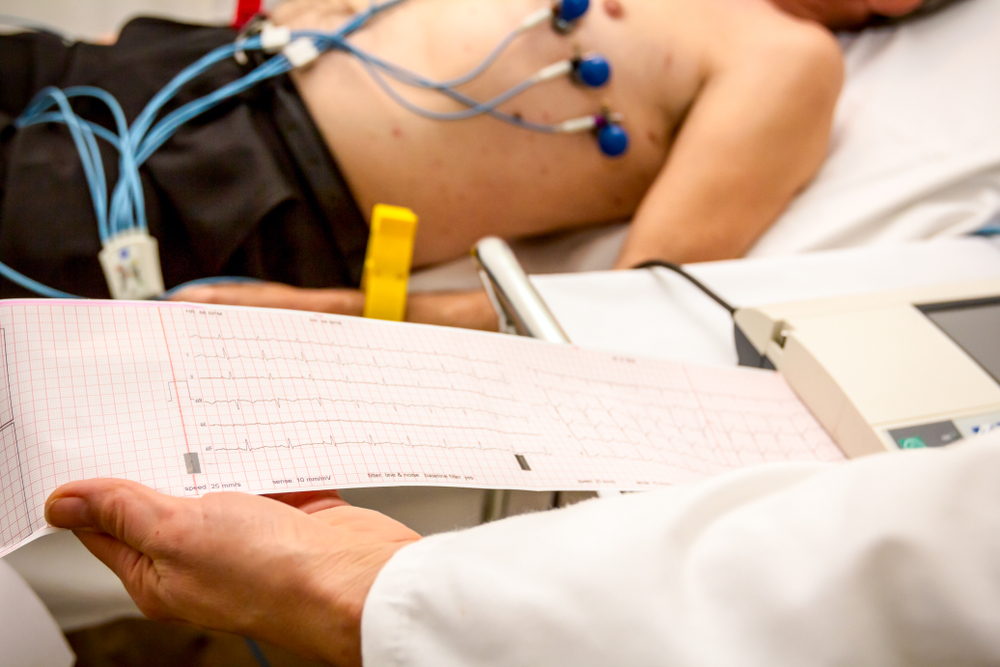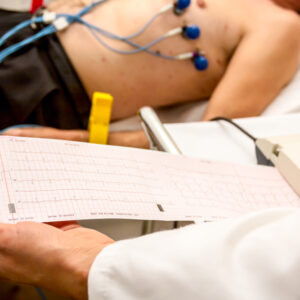What is an electrocardiogram (ECG)?
An electrocardiogram is a test that measures the electrical activity of the heart. It is a quick, safe, and painless procedure used to detect and record the electrical activity of the heart. Whenever the muscles of the heart contract, they produce small electrical signals. Healthcare professionals can monitor these signals using precise electronic instruments to understand the health of the heart.
In addition to evaluating the rhythm and rate of the heart, an ECG can also detect various heart conditions and symptoms such as heart disease and heart enlargement.
What do the different waveforms represent?
An ECG consists of a series of waveforms, namely the P wave, QRS complex, and T wave, which represent the following:
P wave: Represents the electrical activity generated during the depolarization of the atria, also known as atrial depolarization wave.
QRS complex: Reflects the rapid depolarization process of the left and right ventricles.
T wave: Also known as the repolarization wave, it represents the electrical activity of the ventricles recovering or returning to a resting state.
What are the 3 types of ECG? What is the difference between static and dynamic?
Static Electrocardiogram (ECG):
Purpose:
- To determine if the cardiac electrical activity is normal.
- Doctors can assess the conduction speed and regularity of the electrical activity in the heart by measuring the time intervals on the ECG. This helps in identifying any abnormalities such as slow, fast, or irregular heart rhythms.
- To evaluate if the heart muscle is enlarged or stressed.
- By measuring the amount of electrical activity transmitted by the heart muscle, cardiac specialists can assess if certain parts of the heart are enlarged or under excessive strain.
Procedure:
- The ECG examination is quick and painless, and patients do not experience any discomfort or risks.
- There may be a slight discomfort when removing the ECG electrodes.
Precautions before the examination:
- Avoid using oily skincare products to ensure proper electrode-skin contact.
- Avoid wearing long stockings, as the electrodes need to be directly attached to the legs.
- Wear a shirt that is easy to remove to facilitate the placement of leads by healthcare personnel.
- Inform healthcare personnel in case of any allergies to adhesive tapes or adhesives used for attaching electrodes.
Time required:
- Approximately 10 minutes for preparation and completion of the test.
- The actual recording process takes only a few seconds.
Holter Continuous Electrocardiogram:
Purpose:
- To allow doctors to observe the heart activity of patients with arrhythmias (abnormal heart rhythms).
- Wearing a Holter monitor provides doctors with insights into the causes of symptoms such as dizziness, lightheadedness, rapid heartbeat, or irregular heart rhythms and determines if the heart is receiving sufficient oxygen to meet its demands.
- To assess the proper functioning of a pacemaker.
- If a patient has a pacemaker and experiences dizziness, a Holter monitor may be used to check if the pacemaker is functioning correctly.
- To evaluate the effectiveness of medication.
- Doctors may observe the ECG to assess the effectiveness of medication during the patient’s treatment.
Procedure:
- Wearing a Holter monitor does not involve any risks or cause pain.
- The wires of the Holter monitor connect to small discs (electrodes) attached to the chest to record the ECG.
Precautions before the examination:
- Inform healthcare personnel of any allergies to adhesive tapes or adhesives used for attaching electrodes.
Time required:
- 24 to 48 hours or longer, depending on the type of monitoring device used.
Exercise Stress Test (Exercise Electrocardiogram):
Purpose:
- To diagnose coronary artery disease.
- To diagnose symptoms possibly related to the heart, such as chest pain, shortness of breath, or dizziness.
- To determine safe levels of exercise.
- To examine the effectiveness of bypass surgery in improving patients with coronary artery disease.
- To predict risk associated with heart disease, such as the risk of a heart attack.
- Based on the results of the exercise stress test, the doctor may recommend further tests such as myocardial perfusion scanning or cardiac catheterization.
Procedure:
- You will be connected to monitoring devices to monitor your heart.
- You will walk slowly on a treadmill. The speed and incline of the treadmill will gradually increase to simulate an uphill effect.
- You can stop the test at any time if needed.
- You may be asked to sit or lie down to examine your heart and blood pressure.
- After the test, you will walk slowly or rest for a few minutes to cool down. Your heart rate, blood pressure, and ECG will continue to be monitored until they return to normal levels.
Precautions before the examination:
- Avoid consuming caffeine or ingesting anything within 12 hours before the test.
- Avoid eating or drinking anything except water within 4 hours before the test.
- Do not take cardiac medications on the day of the test unless instructed otherwise by your doctor or if they are needed to relieve chest discomfort.
- If you use an inhaler for breathing, bring it with you to the test.
- Inform healthcare personnel if you experience chest or arm discomfort, shortness of breath, dizziness, or any other abnormal symptoms.
Time required:
- The entire examination takes about 1 hour.
- The exercise duration lasts approximately 7 to 12 minutes.
Abnormal Symptoms that can be detected during an Electrocardiogram (ECG) examination
Rhythm Abnormality
Definition: Arrhythmia refers to irregular, fast, slow, or abnormal heart rhythms. Patients may sometimes not feel any symptoms, but in other cases, they may experience noticeable palpitations or a sensation of “heart fluttering.” If you experience any abnormal heartbeats, it is important to seek medical help immediately so that the doctor can identify the cause and provide appropriate treatment.
Symptoms Reflected in the ECG:
- Sinus Bradycardia (slow rhythm/fast rhythm)
- Sinus Tachycardia (fast rhythm)
- Atrial Fibrillation (coarse/fine)
- Atrial Flutter
- Ventricular Rhythm
- Ventricular Tachycardia
- Ventricular Fibrillation
- Sinus Arrhythmia
- Missed beat at 80/120 BPM
- Paroxysmal Atrial Tachycardia (PAT)
- Nodal Rhythm
Electrical Conduction Abnormality
Definition: Conduction abnormalities refer to problems in the heart’s electrical conduction system, which controls the rate and rhythm of the heartbeat. Normally, the heart releases electrical signals to stimulate the contraction of the heart muscle, pumping blood to the lungs and throughout the body. If there are abnormalities in the conduction system, it can result in the inability to generate electrical signals properly or stimulate the heart muscle, posing a threat to the body and even life-threatening. Therefore, if you suspect any irregularities in your heart rhythm, immediate medical attention should be sought.
Symptoms Reflected in the ECG:
- First Degree A-V Heart Block
- Second Degree A-V Heart Block
- Third Degree A-V Block
- Right Bundle Branch Block (RBBB)
- Left Bundle Branch Block (LBBB)
- Premature Atrial Contraction (PAC)
- Premature Nodal Contraction (PNC)
- Premature Ventricular Contraction (PVC)
- Bigeminy
- Trigeminy
- Couplet (Two PVCs together)
Structural/Functional Abnormality
Definition: Structural or functional abnormalities of the heart refer to defects or abnormalities in the heart’s internal valves or blood vessels, causing an improper flow of blood. These abnormalities can involve various locations within the heart, such as the heart walls, valves, arteries, or veins. Structural heart diseases can be congenital or acquired, and some structural abnormalities may not be detectable in childhood and may only become apparent in adulthood. Statistics show that about 1 in every 150 adults has some form of congenital heart disease.
Symptoms Reflected in the ECG:
- Right Bundle Branch Block (RBBB)
- Left Bundle Branch Block (LBBB)
- Ischemia
- Ventricular Hypertrophy
Risks or side effects of ECG examination
The ECG examination is generally safe and poses no significant risks or side effects to the patient.
Precautions before the ECG examination:
- Avoid vigorous exercise for 1 hour before the examination.
- Avoid smoking.
- Avoid consuming stimulating and caffeinated beverages like coffee or tea.
- Avoid wearing items that may interfere with electrical conduction, such as metal jewelry, watches, socks, etc.
Price of Electrocardiogram (ECG) Examination in Hospitals/Clinics
Resting Electrocardiogram: $304 – $1,650
Holter Monitor Electrocardiogram: $2,100 – $9,910
Exercise Stress Test Electrocardiogram: $2,300 – $4,410
- *The above fees were collected by the Bowtie Healthcare Information Team on April 12, 2023. For more details, please inquire with the respective hospitals or clinics.
Frequently Asked Questions:
Generally, the normal range for an ECG is a heart rate of approximately 60 to 100 beats per minute.
If you don’t have any known heart problems, an annual ECG is sufficient to monitor your health. However, if you have known heart conditions, regular ECG tests are recommended. The actual frequency and type of ECG will vary depending on individual circumstances. Please consult with your doctor for specific recommendations and arrangements.
ECG Monitor






